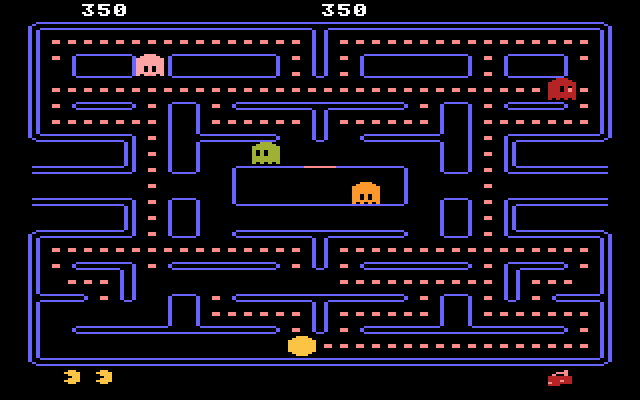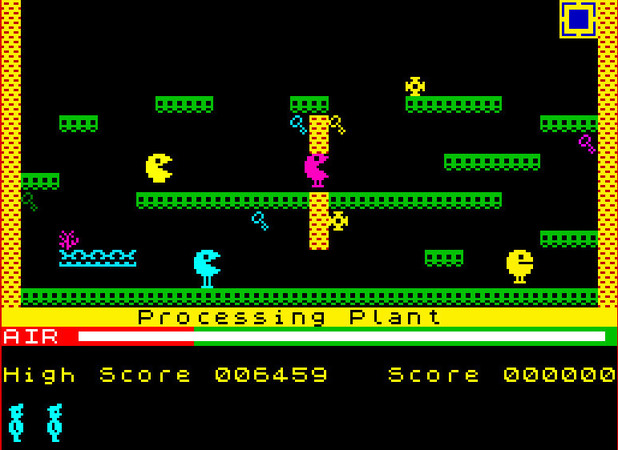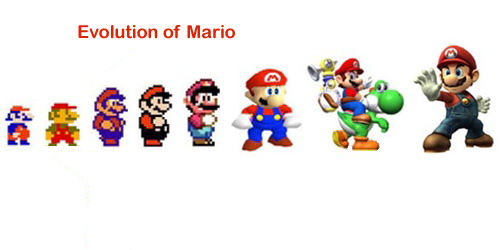
In 1980 the game previously named 'Puck-Man' (featured above), but changed to the less tamperable name 'Pac-Man' when realised in America, resembles the start of real character design in games. You play as a hungry yellow creature who eats everything and destroys evil along the way, which as a gamer gave you a real sense of compassion and interaction with the character because of his attached personality, even the enemies had the designated name's; Winky, Pinky, Inky and Clyde. Which was never present before in games as you just played as a generic spaceship or blob. Subsequent to the clever addition of a lovable character, that could chomp his way around a two dimensional maze avoiding baddies, females began to divulge and interest in the game. Possibly because it veered from the masculine games where you blow things up. However Toru Iwatini, the creator of the game, claims to have anticipated the sudden interest from females as it involves eating. Which admittedly isn't something i would deem appealing to girls, but he is the genius.
'Pac-man' became so popular Midway were making 1200 machines a day. An extreme case of its popularity that i found in an article, is about a boy who was so addicted to the game he played it for a continuous 31 hours on one quarter before he finally died. This emulates the hypnotic power video games posses, which to me is quiet scary.

Soon after, the infectious Pac-Man was overtaken by 'Asteriods' (seen above) the latest craze in video games, which offered more influential features to the games we have today. 'Asteriods', created by Ed Logg from Atari, was the first game to feature five buttons as apposed the previous use of joysticks, which called upon ambidextrous people to apply a certain amount of skill to play the game. 'Asteriods' was also the the first game to enable the player to enter their name into the high score menu, which created a new kind of interaction and rivalry in playing the games. Another of the games significant traits were its graphics, it used wire frame vector graphics which produced crisper lines for better aesthetics.
Along with Asteroids many other ground breaking games came from the 1980s, such as the Atari games 'Defender' made by Eugene Jarvis, 'Missile Command' made by Dave Theurer and 'Battlezone' made by Ed Rotberg.
At this point America and Japan were at the forefront of computer games, while Britain was falling behind. A few renditions of the game 'Pong' ruled our arcade's for a while, but it was Clive Sinclair who redeemed the games industry in Britain in 1980 by creating the 'Sinclair ZX80' the UK's first mass market home computer for the less than £100. It was Sinclairs aim to have a computer in every British home, and his later computer the 'ZX Spectrum' was. Naively bought by parents for the children to do homework on, the 'ZX Spectrum' (seen below) became the hub for a new generation of games. The 'ZX Spectrum' enabled the player buy games that simply slotted into it and even allowed them to buy magazines that had games you could programme in yourself, which encouraged even the least inexperienced of users to become games programmers.

'Manic Miner' (seen below) a game produced by 'Bug Byte' inspired by the Atari's 'Miner 2049er', was Britain's first software blockbuster, a game in which you had to venture through twenty screens of brightly coloured two dimensional platforms, as the humorously named character 'Miner Willy', collecting keys and trying to reach the end without dying. It was the first game on the 'ZX Spectrum' to feature in game music and was thought impossible to do. I have played the game recently and though it sounds simple it is actually quite hard to complete. I will add a link for it online. Though it holds no significance, the creator of this self programmed game 'Mathew Smith' Mysteriously disappeared for a couple of years after creating his second game 'Jet Set Willy' and websites had recently been put up to help locate him. I personally think he was just recovering from the amount of years it must have taken him to programme the two games by himself.

In America 1983, the video games industry hit a wall and many arcades closed down, the console market collapsed, powerful home computers made Atari's 8 year old VCS look ancient, also a swarm of terrible games for the consoles were realised and dampened the fixation and novelty of having a console at home, however when consoles such as Clive Sinclairs Spectrum allowing any average Joe to write their own games it was bound to lose its marvel over the years.
In 1985 Shigeru Miyamoto saved the games industry by bringing 'Nitendo' into fruition. Originally starting out by selling playing cards and toys, Nintendo marginally began to venture into the video games industry by securing rights to distribute the Magnavox Odyssey video game console in Japan in 1974. However Nintendo then began to produce its own hardware in 1977, with the Colour TV home video game consoles. Four versions of these consoles were produced, each including variations of a single game. Soon Nintendo had taken over Atari as the iconic console to own, and with the production of ground breaking games such as 'Super Mario' - 1983 and 'Donkey kong' - 1981 it is understandable how they accomplished it. The introduction of 'Super Mario' was vastly influential to the games industry and more specifically two dimensional platform games. People found it invigorating to play as an average short Italian plumber who could save princesses and fight bosses, his iconic face had become more renowned than that of Micky mouse. For a man who started at Nintendo doing graphics for packaging, Shigeru Miyamoto definitely made the right choice by moving onto making computer games, as his lovable Mario is still appearing on our screens twenty years later.

Nintendo continued to rein in the 80s subsequent to it filling a niche gap in the games industry for a handheld console by creating the 'GameBoy'. The innovative idea of having a mobile games console you take with you appealed to both adults and children and its selling point was that by buying it you could play the newly realised and addictive game 'Tetris' made by Alexey Pajitnov in 1985. The game is claimed to be so additive because of our human nature to wants things to be straight and tidy, testing ourselves in trying make the geometric shapes fit neatly. Sadly Alexey Pajitnov didn't actually get any money for the game as it was technically owned and sold by the Soviet Union to Nintendo.

In the 1990s the PlayStation 1 was produced. it was considered the console that made video games cool, and seen in nightclubs across the UK featuring fast pace racing games such as 'Wipeout' in 1995. One of the most significant early games to come out on the PlayStation 1 was 'Tomb Raider' - 1996 (Featured below), in which the role of Lara Croft is played. Not only was it strange to have a women as the heroic character, it was also strange seeing the world in a three dimensional form. It is considered widely influential, serving as the template for many three dimensional action/adventure games that followed. However such a diverse game was not easy to make, not like the two dimensional games you could programme yourself on a Spectrum. The creator Toby Gard had a team of artists, musicians and programmers working with him on the game which was never seen in the production of games before. 'Tomb Raider' depicted how much video games had matured and developed since minimalist games like 'Pac-Man'. The game opened the door to a new genre of games, ones in which story lines and dynamic individual characters could be portrayed in game, allowing for a greater sense of involvement and attachment in the game as you play. This is also evident in Shigeru Miyamoto's Nintendo game 'The legend of zelda' - 1998. Along with the iconic PlayStation 1, the lesser known consoles 'Sega Genisis' and Nintendo 64' were produced in the 1990s which also enabled the next genereation of games to spawn.

With the gradual appearance of handheld consoles, smaller and more powerful home consoles and the higher standard of games beginning to develop such as that of the epic 'Tomb Raider', it is clear to see that the games industry in this time period in slowly starting to portray signs of the battle that now exists between games companies.
No comments:
Post a Comment